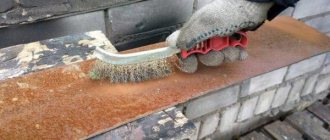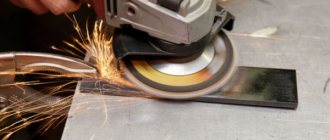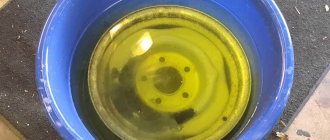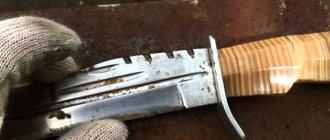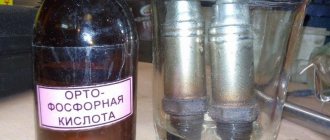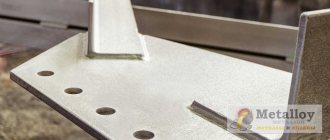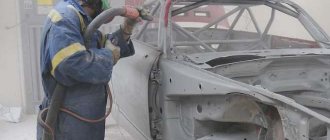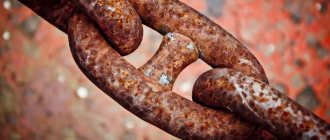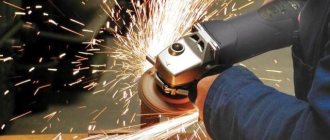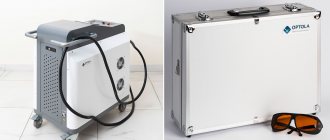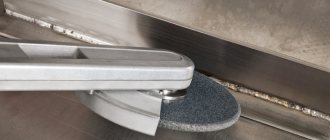The appearance of rust on metal surfaces and parts is a very common phenomenon that is often encountered not only by motorists. Corrosion is a chemical reaction that causes damage to metal. Cleaning rust from iron at home is one of the frequently asked questions that does not have a definite answer. In this material we will look at all possible ways to combat corrosion, and what tools, preparations and improvised means will be needed for this.
Rust on metal - causes of its occurrence
The first and very important question with which you need to start fighting corrosion involves finding out the cause of its occurrence. Having learned the reasons for the reaction, you can not only choose the optimal method for removing corrosion, but also prevent its reoccurrence.
Why does metal rust? The main reason for the reaction is the composition of the metal. It consists of various compounds such as oxygen, carbon, sulfur and others. It is these components that become the result of the appearance of rust stains on metal parts placed in water or a humid environment.
This is interesting! Pure metals do not rust, and these include gold, silver and platinum.
Metal in contact with air forms oxides, and with moisture - hydroxides. The effect of moisture and oxygen on metal contributes to its destruction, and the thinner the steel, the faster the process of its destruction occurs. This phenomenon is called corrosion, and the result of its occurrence is rust. It is almost impossible to avoid the occurrence of these processes, but various methods and techniques are used to reduce the rate of corrosion development.
Corrosion is a long-term process, so the destruction of metal products requires a long period of time, which directly depends on the thickness of the iron. It follows from this that the main reasons for the appearance of rust on metal are the following factors:
- Exposure of untreated metal to oxygen and moisture. In this case, the part does not necessarily have to be in a damp room. If you store a metal product in a dry and ventilated area, then signs of corrosion will also form after some time.
- Lack of special protective coatings - these include not only varnishes and paints, but also zinc coatings, which provide highly effective protection against the destructive effects of corrosion.
- Type of steel - high-alloy steels are susceptible to rusting with less intensity, which is due to the low percentage of carbon in the composition. However, such steels are quite expensive, so they are used for the manufacture of various high-precision parts or consumables for power tools.
Many people mistakenly believe that a type of steel such as stainless steel does not rust. We will not go into details of the composition of this material, but it is worth noting that even stainless steel is subject to the corrosion process. This is due, first of all, to the fact that the chrome film, which forms upon contact with oxygen, and thereby protects the metal from rust, is damaged, which ultimately leads to the appearance of rust.
To summarize, it should be noted that metal rusting is a normal natural phenomenon, which is a global problem for humans. And we are talking not only about problems with a rusting car body, but also about such global disasters as the sinking of ships, the destruction of bridges, etc., provoked by rusting metal.
Hydrochloric acid
It acts as quickly as nitrogen. The metal begins to turn white literally before our eyes. Since the reaction process produces hazardous gases, you should not get too close to the container in which the treatment is being carried out.
A slower, but also safest method of cleaning is to mix the acid with flour. Its addition will significantly reduce the rate of metal etching. However, it will take more time to remove the rust. You can also try adding methenamine, which is a corrosion inhibitor (suppressant), to the hodgepodge.
When processing any of the acids to neutralize its residues, the product must be washed in ammonia or a weak alkaline solution of soda or soap. Please note that after removing the oily film, the metal product can literally turn red again within half an hour. Therefore, after cleaning with an anti-rust agent, it must be immediately wiped dry or thoroughly calcined so that the water completely evaporates.
The part is then lubricated, coated with a layer of zinc or painted. If it is not possible to treat the metal with an anti-corrosion compound in the near future, it is coated with a spray bottle with a mixture of lithol (solidol) and gasoline.
Harm from rust or why you need to fight it
Everyone knows the danger of corrosion. In addition to the fact that the appearance of the metal part deteriorates, it also begins to lose its mechanical properties - strength, elasticity, rigidity, etc. Many people do not pay attention to the appearance of rust spots, which increase in size over time. The main danger of corrosion is that it corrodes the metal inside, making it ultimately unusable. As a result, you have to buy new parts, which causes additional costs.
The reasons for the need to combat rust are known. This must be done not only to protect the part from complete unsuitability, but also for aesthetic purposes. Moreover, the process of combating corrosion must be approached responsibly. An incorrect approach will only accelerate the rusting process, and in a short period of time it will fail.
Industrial methods of prevention
In addition to forced rust removal, there are methods to prevent metal oxidation. These include:
- galvanic treatment;
- cathodic protection;
- application of inert coatings.
It is problematic to apply these methods in everyday conditions due to the lack of appropriate equipment and the complexity of technological processes.
Galvanization
The method involves depositing a thin layer of a substance that is slightly susceptible to oxidation onto ferrous metal using electrolysis. The nuance of the situation is that as soon as the protection is broken, corrosion immediately begins.
Cathodic protection
A method that involves the use of a direct current source that creates a zone of negative electrical potential on the protected surface. Successfully used on large objects (ships).
Special coatings
Protection methods using specially applied metal coatings may be no less effective than others. Typically, they are made using substances that do not react with condensation or moisture.
Galvanization
Coating with a layer of zinc perfectly protects the base metal from oxidation and makes it inert towards slightly aggressive environments. Widely used to protect body parts, in the manufacture of hardware and fasteners.
Tinning
The basis of the method is coating the metal with molten tin solder. The resulting layer resists oxidation well and prevents the spread of corrosion.
Chrome plating
It consists of applying a layer of chromium to components and parts, which is practically not susceptible to oxidation. Allows you to save money by replacing production from expensive stainless steel with production from ferrous metal followed by chrome plating.
Share link:
Cleaning metal from rust - special preparations and mechanical methods
To combat metal corrosion, there are three main methods - the use of chemical compounds, mechanical and electrochemical effects (processing). It is simply impossible to answer unequivocally the question of what is the best way to remove rust from metal. To understand why, let's look at the features of each method.
- The chemical method of combating corrosion has its advantages and disadvantages. The products are available in the form of formulations of various consistencies - liquids, gels and even sprays. They contain substances such as acids that come into contact with materials and effectively remove traces of corrosion. However, such preparations can only be used on surfaces of acid-resistant metals. If the metal is not acid-resistant, then substances containing inhibitors should be used to clean it. They remove rust without destroying the structure of the product.
- Mechanical methods - there are a large number of them, as well as drugs to combat corrosion. If in the first case the removal of corrosion stains occurs automatically due to a chemical reaction, then the mechanical method involves physical action. The most common method is to use sandpaper or files.
- Electrochemical - the principle of their operation is based on passing an electric current through a calcium solution. In this case, a reaction begins to occur, through which oxide ions move from the iron to the clean electrode. The method for removing corrosion in this way is called electrolysis, which is used in industry and household activities.
The advantage of the chemical method of combating corrosion is that there is no need to apply physical effort. Anyone who has dealt with rust removal knows how difficult it is to clean the surface to a shine by hand. However, the chemical method has some disadvantages that you should be aware of before choosing and using them:
- when using chemical reagents, you can remove not only rust, but also speed up the process of metal corrosion, which is especially important for steel less than 3-4 mm thick;
- When using reagents, it is important to use protective equipment, since the acids and alkalis contained in the composition can cause a chemical burn if they come into contact with human skin.
Chemicals are very effective, but it is important to use them with extreme caution. This is especially true when removing corrosion from a car body, where the slightest inaccuracy can lead to corrosion of the paintwork.
The mechanical method of removing corrosion, despite its main disadvantage in the form of significant time consumption, is more relevant and in demand. The main reason for its popularity is safety and effectiveness. Next, consider all kinds of ways that will help get rid of corrosion that has arisen on a metal surface.
Soda and salt
Iron and cast iron cookware quickly rusts from frequent contact with water. To remove rust from metal utensils, follow these tips from Cosmopolitan magazine:
- Scrub the item with an abrasive wire brush. This will remove burnt food debris and the top rusty layer.
- Dry with a cloth towel.
- Place the pot/pan on the stove (high heat). Heat until pan is evenly hot.
- Mix baking soda and table salt in equal proportions.
- Apply the mixture to the hot item.
- Rub the problem areas with a brush or rough cloth. As you rub, the mixture will darken and the cast iron will become clearer.
- Remove any remaining salt and soda. Dry the product clean with a dry cloth.
If you need to clean iron tools, do not heat them. Prepare a mixture of salt and soda, add a little water to make a homogeneous thick paste. Apply the mixture to the rusty areas, let it sit for 30 minutes, then scrub with aluminum foil or a brush.
After such cleaning, the integrity of the surface structure of the metal is compromised, so it is necessary to apply protective agents. The sealant will block the access of water and air to the metal, stopping the further spread of rust.
Salt will help get rid of rust: Unsplash / blackieshoot
Chemicals and traditional methods for effectively combating rust
Corrosion problems have been known for a very long time, and if now there are many different chemicals that can quickly and effectively remove rust stains, then previously improvised means were used instead. We will consider methods for removing corrosion using chemicals in more detail below.
Acetic acid is a cheap and effective drug
To quickly and cost-effectively remove rust from metal, you need to use 70% acetic acid or essence. You can also use regular vinegar. Fill the container with acid and place the part in it. After 2-3 hours, the workpiece can be removed from the container and the effectiveness of this drug can be verified.
Acetic acid can also be poured into a spray bottle, and thus treat a large surface. It is important to use safety glasses to prevent the drug from getting into your eyes. There is no need to talk about vinegar being 100% effective, but it all depends on the layer of rust on the part. After using this method, the workpiece should be thoroughly dried, and only then begin to apply additional protective agents.
Baking soda will help remove small pockets of corrosion on the metal surface.
Another product that is available in the kitchen is soda. It helps remove rust stains on metal surfaces. The principle of the procedure is to perform the following actions:
- Prepare a mixture by diluting soda with water and stirring thoroughly to obtain a porridge-like substance.
- Apply the resulting mixture to the area of rust formation and rub thoroughly using an unsuitable toothbrush.
- Wait a few hours, then rinse the surface thoroughly.
The procedure can be repeated several times to achieve an effective result. You can use soda not only to clean rust from kitchen utensils, but also from various parts.
Citric acid - removing rust in hard-to-reach places
Many have faced the need to remove metal corrosion in hard-to-reach places. If the outer surface can be sanded with sandpaper, then it is almost impossible to get into the internal cavities. In this case, a kitchen preparation such as citric acid will help.
In addition to effectively combating corrosion, citric acid is harmless to the skin of the hands, but in any case, it is recommended to use special gloves. The effectiveness of rust removal depends on the concentration of citric acid. It is recommended to dilute the powder with warm water in a proportion of 80 grams of acid per 100 ml of liquid. Next, the part is placed in a container with the solution for several hours, and after that it is removed.
Oxalic acid is a special preparation for fighting rust
Oxalic acid must be handled with care and with the obligatory use of protective equipment. The work algorithm involves performing the following actions:
- Pre-wash the part and dry it.
- Prepare a solution by dissolving six teaspoons of powder in 300 ml of water.
- Immerse the object in acid and remove it after half an hour.
- Remains of rust are removed with a toothbrush.
Acid copes not only with metal corrosion, but also with various surface contaminants.
Hydrochloric acid is a quick way to combat corrosion
To clean the surface of a metal product from rust, it is enough to treat it with a 2 percent solution of hydrochloric acid. When using this product, it is also important to follow safety precautions and use protective equipment.
Rust destroyers
You've probably come across drugs called rust destroyers or rust cleaners in hardware stores. They are liquid consistencies based on various acids that come into contact with metals.
The products are quite effective drugs, but they must be used carefully. They are not only dangerous to humans, but also to the hardware itself. Excessive amounts of acid will not only remove the corrosion, but also damage the metal.
In addition to destroyers, there are drugs such as converters. Their main difference from exterminators is that after treatment with such materials, the surface does not need further treatment with primer compounds. After the converter has dried, you can begin painting the surface.
Hydrogen peroxide - how effective is the drug?
If you need to remove rust from a bathtub, toilet bowl or cutlery, then you can use harmless hydrogen peroxide. The drug itself is not so effective, so it is recommended to use it together with trisodium phosphate. To prepare the product, you must perform the following steps:
- Dilute trisodium phosphate powder in 3 liters of water.
- Add 50 ml of hydrogen peroxide.
- Use the product to wet or wipe surfaces with traces of corrosion.
A popular drink such as Coca-Cola is also used to remove rust. This delicacy has this property due to the fact that it contains phosphoric acid. The process of removing corrosion with Coca-Cola takes a very long time (at least 20 hours), but the result cannot be pleasing to the eye.
This is interesting! In small quantities, the Coca-Cola drink is harmless to the body, but if it is consumed in large doses and constantly, one can imagine its negative impact on human organs.
An alternative to sandpaper is foil, which can be used to clean and remove minor rust on the metal surface. The methods listed above to combat corrosion are considered the best available means. However, to remove rust from important parts, you will need to use more significant methods.
Chemical solvents and corrosion converters
Many people don't want to wait for hours for a layer of rusty deposits to soak and move away from the metal. To reduce waiting time, you can buy a special cleaner at a hardware or hardware store. Special compounds quickly clean the metal from the effects of corrosion. They are used in auto repair shops, in production, and in metalworking.
Purchased formulations are divided into two groups:
- Converters - used to apply a protective layer to metal.
- Solvents - used to remove a layer of rust.
Converters
Converters are special solutions made from tannin or phosphoric acid. In the store you can find converters in the form of a liquid, suspension or emulsion. It is considered a chemical way to protect metal surfaces from the development of corrosion processes. Before applying the converter, the metal must be cleaned of crumbling deposits.
Solvents
To quickly remove rust from metal, you can use a special solvent. A well-known effective remedy is the composition “BCH-1”. It is easy to apply to damaged areas.
The active components of solvents are phosphoric or oxalic acid. Instructions for use are indicated on the plastic container. Due to their low price, such compositions are popular in home workshops.
Mechanical methods of combating metal corrosion
How to remove rust from metal? The easiest way is to use sandpaper or a metal brush. The disadvantages of this method are known to everyone - the expenditure of effort and time, but even with these disadvantages, the method continues to remain relevant, and moreover, it is very popular.
To remove rust from metal surfaces mechanically, the following tools, consumables and devices are used:
- Hand brush for metal - the tool is a regular brush with a handle, but instead of the usual bristles it uses metal bristles. The wire-shaped bristles have varying stiffness, thereby ensuring their penetration into the smallest pores on the surface of the iron. Brushes are used to remove rust only in cases where there is a large layer of corrosion and dirt on the surface of the part. However, we can’t talk about 100% efficiency, since the brush removes only superficial deposits and is not able to clean out the orange deposits from the pores.
- Mechanical brushes (cord brushes) - the effectiveness of removing rusty deposits on the metal surface depends on the speed and frequency of passage of the bristles through the metal. Especially for such cases, special attachments for power tools have been developed - mechanical brushes for metal. The products are available in different shapes, types and configurations, which allows you to use the best option for cleaning various surfaces. The brushes are suitable for electric drills and angle grinders. Despite the simplicity of the design of the nozzles, it is quite difficult to work with them due to centrifugal force. When the nozzle touches the surface being treated, the tool tends to escape from your hands, so it is very important to hold it with both hands. When working, you need to use protective equipment, which is due to the formation of large amounts of metal dust. In addition, the separation of lint cannot be ruled out, which, at high rotation speeds of the nozzle, can get stuck in the skin. To eliminate such consequences, it is recommended to carry out work in special clothing. The bristles on the brushes can be coated with a layer of brass. This is done so that during the cleaning process a protective brass film is created on the treated area.
- Sandpaper – You can remove rust using sandpaper. This is one of the most effective means, the main advantage of which is the ability to select fractions of suitable size. Sandpaper should be selected depending on the size of the pores present on the workpiece. The disadvantage of using sandpaper is that the process is complicated and time-consuming.
- Power Tools for Sandpaper - To remove corrosion from metal using sandpaper, it is recommended to use power tools. These include drills, grinders and grinders. Special round attachments are designed for fastening in the chuck of a drill (screwdriver) or the spindle of an angle grinder. Sanding sheets are used on sanding machines. The downside to using power tools with sandpaper is that you have limited access to tight spots. And therefore, especially for such cases, a type of tool such as a sandblasting gun was invented.
- Sandblasting gun or sandblasting equipment - the products have a simple design, but their main advantage is the high quality of rust removal. The operating principle of the equipment is based on cleaning the surface using grains of sand. Sand flies out of the nozzle of a special nozzle, called a gun, under the influence of compressed air pressure. Due to the high air pressure, the speed at which grains of sand fly out increases, which, when they hit the surface, clean the rust. Today, sandblasting equipment is the most effective means for high-quality cleaning of metal surfaces from rust.
Knowing what mechanical methods exist to remove corrosion from metal, it will not be difficult to choose the appropriate option or try all methods. It is important to note that when using sandblasting equipment it is important to consider the following:
- The devices have high power, so it is not recommended to use them for processing thin sheet metal.
- Sandblasting machines can easily cope not only with rust, but also with cleaning the surface of dirt and paintwork.
- The efficiency of the equipment depends on the type of sand used - river, quartz, corundum, etc.
Moreover, it is important to understand that the installations effectively remove rust not only in open areas, but also in hard-to-reach places. To reliably and effectively combat rust formed on metal, it is recommended to give preference to sandblasting machines.
Professional products
Professional chemicals help quickly remove complex stains. Converters and solvents come in different forms: liquid, spray or gel. The technician does not need to worry, because everything that is necessary to remove rusty deposits is already included in the chemical - this is the main advantage.
Solvents
Any solvent will help clean a rust-covered element. Effectively removes kerosene and diesel deposits. The process is long, the element must be kept in the active substance for about a week. During this time, the rust will completely dissolve, and the metal itself will remain intact.
Converters
To clean metal parts, you can use special anti-corrosion converters. Such compositions form a special protective film and act without damaging the material itself. Products can be acidic or neutral. In the latter, the active component is zinc.
To remove rust with a converter, you need to follow this algorithm:
- Clean the item from dirt and loose rust using a metal brush or sandpaper.
- Rinse the metal with water, dry it, and degrease it with white sprit.
- Apply the converter to the metal in 1 layer, and after 30 minutes repeat the procedure.
Attention! It is professional products that ensure effective rust removal without losing the properties of the material being processed. Their only drawback is the price. The cost of the converter is much higher than that of other available purifiers.
Electrochemical method of rust removal using the example of a car body
Particular attention should be paid to such a method of combating corrosion as the electrochemical method. It is immediately worth noting that this method is suitable for combating corrosion on any type of metal surfaces, including car bodies.
The essence of this method is based on provoking electrochemical corrosion. Metal conducts electric current, and depending on its magnitude and voltage potential, atoms are aligned in a certain chemical series.
The electrochemical corrosion removal method is also called cathodic protection. Why protection? This method allows not only to remove corrosion, but also to apply a protective zinc film to the metal. All this can be done at home. And if the method of removing corrosion using sandblasting equipment does not suit you, then we will consider in detail how you can eliminate corrosion on a car body using the electrolytic method.
Initially, you need to prepare the necessary tools and materials. For this you will need:
- DC source. You can use a car battery, but it is recommended to use a charger with current and voltage indicators, as well as a step regulator.
- A container made of material that does not conduct current. This is in case you plan to process the removed part.
- Aqueous solution - it is recommended to use baking soda or soda ash as the medium in which the reaction will occur. An alternative is a pipe cleaner called "Mole". It contains sodium.
- The positive electrode acts as an anode. It is recommended to use stainless steel material as an electrode. The metal used must be a conductor of current, but only with less conductivity than the metal being processed.
- To ensure the procedure is carried out correctly, you will need one more important detail - a fabric insert on the anode. It not only eliminates the occurrence of a short circuit, but also allows you to apply an aqueous solution to the area that needs to remove corrosion.
As you can see, every home craftsman has all the necessary materials and tools in his arsenal. After preparing the necessary tools, we move on to creating a tool for electrolytic cleaning of metal from corrosion.
- Initially, it is necessary to attach an electrode to the positive contact (terminal) from the charger or car battery. As an alternative, we use a stainless steel spoon.
- Next, a woven material must be wound around the electrode attached to the positive terminal. You can use a sponge or any cloth. The reaction speed depends on the thickness of the fabric, and the thicker it is, the slower the anodizing process.
- The tool for removing rust from a car body is almost ready for use. All that remains is to secure the negative terminal from the charger to the car body. If a battery is used, then the “ground” is already on the car, and you can begin to manipulate it.
- Prepare an aqueous solution using the “Mole” product. To speed up the process, you can add soda ash or sodium to the solution. If you use regular soda, then 1 tablespoon per 1 liter of water is enough.
- By wetting the anode sponge, we treat the area on the car body with signs of corrosion. It is very important to pre-clean this area of contamination. The saffron caps should also be cleaned of paintwork to ensure that corrosion in these areas is removed.
- Before starting the procedure, connect the charger to the network and set the current. The current strength depends on the size of the part, so we proceed as follows. If saffron milk caps are removed, as shown in the photo above, then we set the current to 6-8 Amperes. It will be quite enough. If you need to clean a large part from corrosion, for example, a car wheel, then you will need a larger current, 10-15A. However, it is important not to overdo it here, since this way you can burn the memory.
- Let's get down to business - wet the woven part of the anode in the solution, and clean the area on the car with signs of corrosion. In just a few minutes you can see how the rust begins to dissolve.
- After thorough treatment, it is necessary to rinse the treated area with distilled water. Using plain water with a salt solution will worsen the situation.
- After cleaning the rust on the car body, you can proceed to the next stage - protecting it with galvanizing and painting.
To galvanize a car body at home, a similar tool is used. The only difference is that instead of a stainless electrode it is necessary to use a zinc plate. In order for zinc ions to transfer to the metal and create a protective film, it is necessary to treat the fabric in which the anode is wrapped with soldering acid.
Naturally, the method of electrochemical removal of corrosion from metal is suitable for untreated cases (for example, a car body). The thickness of a car body is 2-3 mm, and if the metal is completely rotten, then there is no point in trying to clean it or save it in any way. In this case, you will need to replace the failed body part. In order not to have to change part of the car body, it is recommended that when the first saffron milk caps are detected, resort to rust removal.
This is interesting! It is important to understand that although saffron milk caps appear on cars on the outside, the reason for their occurrence is hidden inside. In this case, after removing the saffron cap on the outer part, do not forget to check the inside of the part. There is a high probability that the corrosion stain will be more significant on the inside than on the outside.
You don't have to be a chemist to clean rust from metal using the electrochemical method. The procedure is extremely simple and understandable, however, when implementing it, it is important to follow safety precautions and use personal protective equipment (PPE). Below is a video that describes in detail the process of how to remove rust on a car body quickly, efficiently and efficiently.
Method 2. Onion
In order to clean an item with an onion you need:
- Remove the peel from a medium-sized onion;
- chop the onion in a meat grinder or coarse grater;
- mix the resulting mass with 50 ml of glycerin;
- Cover the contaminated area generously with the mixture;
- after 3 hours, remove the mixture and wipe the stained area with half a lemon, cut lengthwise;
- Rinse the product thoroughly and then wash it in the washing machine.
This interesting way to remove rust stains on clothes can be used to clean even delicate fabrics.
Laser cleaning of metal from corrosion
In addition to the methods described above, there is another method of combating metal corrosion. It involves the use of laser equipment. This is a modern technology that is characterized by high speed, quality and efficiency. It has only one drawback - its high cost, so not everyone can afford to use it. Due to the high cost of the method, it is used to clean precious metals from corrosion and plaque.
The advantages of this method include the following factors:
- no release of harmful substances;
- automatic shutdown of the laser beam;
- ability to work with combined materials;
- high speed and quality;
- no need to replace consumables.
The cleaning procedure involves applying laser radiation to areas that need to be cleaned from corrosion. The laser beam acts exclusively on contaminated surfaces. The beam is reflected from clean areas, and damaged areas are heated, thereby removing plaque from them.
During laser exposure, heating causes a transformation of the structure, which ultimately causes plaque exfoliation. As the power of the equipment increases, the process of plaque evaporation occurs. The equipment is capable of heating workpieces to a temperature of 16.5 thousand degrees Celsius. The cleaning process is performed automatically. Initially, the working surface is scanned, and then the focused beam processes the part.
This is interesting! The use of such equipment for home use is irrational due to its high cost.
Vinegar
Synthetic (table) or natural vinegar (apple, wine) is an aggressive product that contains acid. The drug disinfects, kills harmful bacteria on metal, and quickly eats away rust. Author of the book “A Clean House is a Happy Home.” Useful tips on putting things in order and comfort” M. Zhukova offers a simple way to clean taps and other metal objects:
- Dilute table vinegar with water in a 1:1 ratio.
- Spread the resulting solution over all rusty areas with a kitchen sponge. It is better to completely immerse heavily rusted objects in a vinegar solution.
- Leave for several hours (2 to 24).
- Remove items and scrub with a brush if necessary. Afterwards, rinse with water.
The cleaned surface quickly oxidizes, so it is necessary to protect it from oxygen - cover it with lubricant or paint.
Preventive actions
To protect iron from rust, various alloys are used. These include chromium, molybdenum, nickel, sulfur, etc. The disadvantage of these methods is their high cost. A cheaper and more practical means of protecting steel is to coat it with various materials that create a barrier between the surface of the product and the environment. As such coatings, not only varnishes and paints are used, but also coatings made of zinc, chromium, tin, copper and nickel.
Using zinc as a protective layer is not only the most common, but also an effective method. The corrosion process of zinc occurs very slowly, and if applied correctly, the metal part will last at least 20-30 years. If a part has become rusty, its service life can be extended with timely treatment.
To summarize the above, it should be noted that metal corrosion is a normal phenomenon for nature, but abnormal for humans. A person cannot exclude the development of such processes, but it is quite possible to stop them if they choose the right method for removing rust.
Mechanical removal
Since corrosion products have low adhesion, they are easy to remove from the surface of the product by mechanical action. This method is convenient for removing rusty deposits from large, smooth metal surfaces. It is also advisable to use this method for cleaning heavily rusted products as the first stage of completely removing contamination.
The mechanical method includes removing rust using special brushes, grinding wheels, and sandpaper.
To clean large items, you can use a grinding machine, starting with the coarsest grains and finishing with the finest grains. Metal brushes and abrasive attachments for an angle grinder or drill are also suitable. It is more convenient to clean small parts with sandpaper.
Products with complex geometry are difficult to mechanically influence, so it is more effective to use other methods for them.
Note! The areas of metal treated in this way remain without protection from the environment, and therefore, without special treatment, they will become covered with rust even faster.
Some unusual means and methods to remove rust from metal
The list of working anti-corrosion compounds is not complete. There is also Coca-Cola, beloved by many, tomatoes and the electrolysis process.
Coca Cola
Glory to the meticulous American housewives who were the first to notice how a tasty drink can corrode iron oxide. And not only the rust is eaten by the cola, but also the nail itself. There is nothing surprising in this; grapefruit acts in much the same way: both Coca-Cola and the fruit contain phosphoric acid.
How to remove rust from a bicycle? Or how to clean a rusty hammer? Buy a cola and give the item a good bath in it!
It is important not to miss the moment when the object has been cleaned and the drink has not begun to corrode the metal itself.
Salvaging metal from the garden or kitchen: tomato paste or ketchup
The chemical composition of tomato allows it to be used not only for food.
Homemade or store-bought tomato paste will do the job; it’s an excellent tool at hand.
Ketchup or paste is dripped onto the rusty metal, but not washed off immediately: let the substances interact. After 10-15 minutes, the dirt is removed mechanically, and the surface is wiped with a dry cloth.
Electrolysis
There is also a longer, but more effective way to clean metal products.
It is impossible to work properly with such tools.
To clean, you need a container sized for the items, a steel plate for the anode, caustic soda or “Whiteness,” long stranded copper wires (insulated), a battery, a plastic plate (like a screen that protects from contact with the anode), a wire brush and rags.
Attention! The process is quite risky, since if the amperage exceeds the norm for the selected volume of water, the mixture will begin to boil. It is better to carry out work outdoors or in a well-ventilated area.
This method can also be used to clean antique metal finds.
- A solution is created: caustic soda (half a glass) per 15 liters of water.
- The anode is made from wire, installed in a container in such a way that it does not touch its walls.
- Place a round electrode (or steel plate) into the container. No aluminum is used! The length of the anode must be sufficient so that part of it is above the surface of the solution.
- Using an alligator clip, a wire directed to the positive red terminal (from the battery) is attached to the anode.
- A steel plate is lowered into the container, making sure that it protrudes a third from the solution.
- The end of the second wire is attached to the contaminated object. One end of the wire is cleared of insulation, the veins are stripped, and this end is attached to the object. At the point of contact, rust must be removed mechanically.
Important! There should be no free end of the protected wiring that could touch the anode.
All that remains is to attach the second wire to the black terminal. The process will take several hours and the solution will turn dirty brown. Cleaned parts may become dark - such deposits can be removed with a brush.
If you need to clean many parts, they are connected in series to each other with a wire
The more careful you treat metal products, the longer they will last. We invite you to watch a video of the electrolysis process at home:
Causes of metal rusting and why it is dangerous
Rust spoils the appearance and interferes with the normal functioning of products
Rust is the final stage of metal oxidation. The corresponding chemical reaction occurs when the material comes into contact with water (even droplets of moisture in the air are sufficient). The main danger of rust is its destructive effect on metal products, including their appearance. Gradually the material becomes covered with holes and rots. Metal mechanisms become unusable and do not function correctly.
One of the causes of corrosion is damage to the protective coating.
The spread of corrosion is influenced by:
— chips and defects in the paintwork;
— cracks and scratches on the material;
— lack of anti-corrosion treatment.
